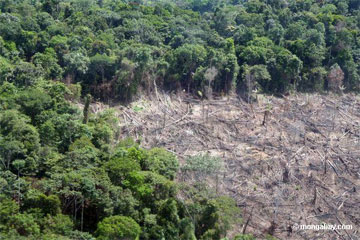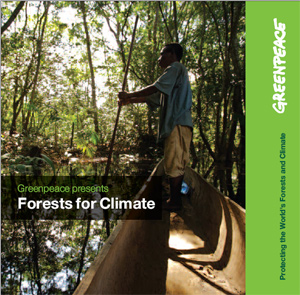Greenpeace calls for carbon fund to save forests and climate
Greenpeace says carbon fund will save forests and climate
mongabay.com
May 20, 2008
|
|
In a report unveiled today at the UN conference on biodiversity in Bonn, Greenpeace announced a plan to save tropical forests through a fund for carbon and other ecosystem services. The plan comes as support grows for the use of market mechanisms to link rainforest conservation to fighting climate change.
“Protecting ancient forests is vital to tackle climate change, preserve global biodiversity, and protect the livelihoods of millions of forest peoples. Tropical forest destruction is responsible for about one fifth of global greenhouse gas emissions, more than from the world’s entire transport sector,” the Forests for Climate report stated.
“Industrialized countries that commit to doing their fair share in reducing energy and industrial emissions would be allowed to meet a portion of their overall commitments through the purchase of cost effective ‘tropical deforestation units.’ A major benefit for industrialized countries is that the units would act as hard currency for compliance purposes, since the mechanism would be responsible for delivering verifiable emission reductions.”

|
Greenpeace says the basis for the system would be “Tropical Deforestation Emission Reduction Units” (TDERUs), newly defined units that would be used for compliance with emission obligations agreed upon in future international climate treaties. Industrialized nations would be required to meet a certain percentage of their emissions obligations using TDERUs purchased from the mechanism. In effect, these countries would pay into a fund to reduce deforestation in tropical nations. The fund would aim to raise $10-15 billion per year — the amount estimated by the UK government’s Stern report on climate change to reduce tropical deforestation by half.
Greenpeace says that funds generated from a Tropical Deforestation Emission Reduction Mechanism (TDERM) would be used for “capacity-building efforts and for national-level reductions in deforestation emissions.” The environmental organization says that national-level reductions in emissions would help prevent “leakage” or the shifting of deforestation from one part of a country to another.
 Forests for Climate |
Greenpeace says that a system based on TDERM would be different from other proposed market mechanisms. It argues that while “a market system would not be open, in the foreseeable future, to all countries in which deforestation occurs due to capacity limitations in relation to the fundamental issues of the scale of credits, emission monitoring, verification and compliance, or in relation to governance issues”, TDERM would allow all tropical deforestation countries to participate, even with their varying levels of capacity. By rewarding countries that “reliably and accurately” report emission reductions, Greenpeace says the system would incentivize countries to improve their forest protection programs.
According to Greenpeace, other benefits from TDERM would include:
- Benefits to climate and biodiversity protection – directs funds to actions that will meet both climate and biodiversity objectives.
- Scale effects on the Annex I emission targets – by limiting the amount that deforestation reductions can be used by the Annex I Parties to meet their commitments, the effects on fossil fuel and other greenhouse gas emissions reductions that are needed can be quantified and limited.
- Pragmatic accounting for uncertainties — the use of the portfolio approach
combined with a discount factor deals pragmatically with the uncertainties relating to emissions estimation, baselines, and permanence. - Ensures stability of market – due to the risks associated with full access to the trading system, the TDERM would issue, in effect, compliance units to Annex I Parties which could not be challenged at price and therefore not affect the stability of the overall market.
- Full access by the widest range of countries – provides funds to the greatest number of developing countries with tropical forests, including countries with varying capacities and governance structures, differing abilities to accurately report, monitor and verify emission reductions, and countries with high and low rates of deforestation.
- Reliable source of funds – a significant and steady stream of funds would be available through the mandatory minimum commitments made by Annex I Parties as part of their overall emission reduction targets.
- Engages indigenous and forest peoples – will motivate and facilitate greater control of forest resources by indigenous and forest peoples and will start to address the problem of local communities becoming sidelined.
- Capacity building and institutional support — reliable funding will be available which can support institutional capacity building needs of developing countries.
While Greenpeace is putting its hopes on what is effectively a non-market system, TDERM will still be challenged by implementation difficulties, governance issues, and acrimonious debate between various stakeholders. Still many believe the time has come to value forests for the services in addition to the products produced when they are cut down.
Forests for Climate
More on carbon finance